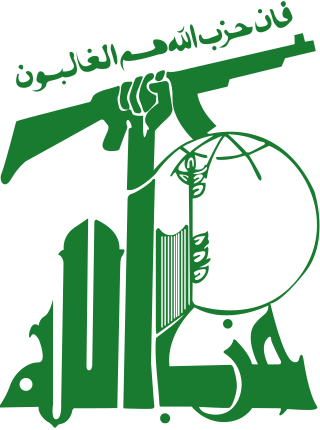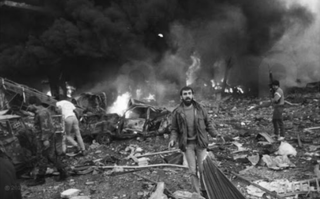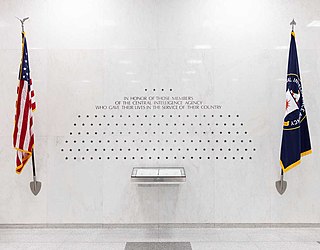
Hezbollah is a Lebanese Shia Islamist political party and militant group, led since 1992 by its Secretary-General Hassan Nasrallah. Hezbollah's paramilitary wing is the Jihad Council, and its political wing is the Loyalty to the Resistance Bloc party in the Lebanese Parliament.

Hassan Nasrallah is a Lebanese cleric and the secretary-general of Hezbollah, a Shia Islamist political party and militant group.

William Francis Buckley was a United States Army officer in the United States Army Special Forces, and a Central Intelligence Agency (CIA) station chief in Beirut from 1984 until his kidnapping and execution in 1985.
The Islamic Jihad Organization, was a Lebanese Shia militia known for its activities in the 1980s during the Lebanese Civil War.

Imad Fayez Mughniyeh, alias al-Hajj Radwan, was a Lebanese militant leader who was the founding member of Lebanon's Islamic Jihad Organization and number two in Hezbollah's leadership. Information about Mughniyeh is limited, but he is believed to have been Hezbollah's chief of staff and understood to have overseen Hezbollah's military, intelligence, and security apparatuses. He was one of the main founders of Hezbollah in the 1980s. He has been described as "a brilliant military tactician and very elusive". He was often referred to as an ‘untraceable ghost’.

On October 23, 1983, two truck bombs were detonated at buildings in Beirut, Lebanon, housing American and French service members of the Multinational Force in Lebanon (MNF), a military peacekeeping operation during the Lebanese Civil War. The attack killed 307 people: 241 U.S. and 58 French military personnel, six civilians, and two attackers.

Theodore George "Ted" Shackley, Jr. was an American CIA officer involved in many important and controversial CIA operations during the 1960s and 1970s. He is one of the most decorated CIA officers. Due to his "light hair and mysterious ways", Shackley was known to his colleagues as "the Blond Ghost".

The Amal Movement is a Lebanese political party and former militia affiliated with the Shia community of Lebanon. It was founded by Musa al-Sadr, Mostafa Chamran and Hussein el-Husseini in 1974 as the "Movement of the Deprived." The party has been led by Nabih Berri since 1980. The Greek Catholic Archbishop of Beirut, Grégoire Haddad, was among the founders of the movement.

On 8 March 1985, a car bomb exploded between 9 and 45 metres from the house of Shia cleric Sayyed Mohammad Hussein Fadlallah in Beirut, Lebanon, in a failed assassination attempt by a Lebanese counter-terrorism unit linked to the Central Intelligence Agency. The bombing killed 80 people and injured 200, almost all civilians.
Psychic driving was a psychiatric procedure of the 1950s and 1960s in which patients were subjected to a continuously repeated audio message on a looped tape to alter their behaviour. In psychic driving, patients were often exposed to hundreds of thousands of repetitions of a single statement over the course of their treatment. They were also concurrently administered muscular paralytic drugs such as curare to subdue them for the purposes of exposure to the looped message(s). The procedure was pioneered by Donald Ewen Cameron, and used and funded by the CIA's Project MKUltra program in Canada.

William Richard Higgins was a United States Marine Corps colonel who was captured in Lebanon in 1988 while serving on a United Nations (UN) peacekeeping mission. He was held hostage, tortured and eventually murdered by his captors.
"Enhanced interrogation techniques" or "enhanced interrogation" was a program of systematic torture of detainees by the Central Intelligence Agency (CIA), the Defense Intelligence Agency (DIA) and various components of the U.S. Armed Forces at remote sites around the world—including Bagram, Guantanamo Bay, Abu Ghraib, and Bucharest—authorized by officials of the George W. Bush administration. Methods used included beating, binding in contorted stress positions, hooding, subjection to deafening noise, sleep disruption, sleep deprivation to the point of hallucination, deprivation of food, drink, and medical care for wounds, as well as waterboarding, walling, sexual humiliation, rape, sexual assault, subjection to extreme heat or extreme cold, and confinement in small coffin-like boxes. A Guantanamo inmate's drawings of some of these tortures, to which he himself was subjected, were published in The New York Times. Some of these techniques fall under the category known as "white room torture". Several detainees endured medically unnecessary "rectal rehydration", "rectal fluid resuscitation", and "rectal feeding". In addition to brutalizing detainees, there were threats to their families such as threats to harm children, and threats to sexually abuse or to cut the throat of detainees' mothers.
The Lebanon hostage crisis was the kidnapping in Lebanon of 104 foreign hostages between 1982 and 1992, when the Lebanese Civil War was at its height. The hostages were mostly Americans and Western Europeans, but 21 national origins were represented. At least eight hostages died in captivity; some were murdered, while others died from lack of adequate medical attention to illnesses. During the fifteen years of the Lebanese civil war an estimated 17,000 people disappeared after being abducted.
The Constitution of the United Arab Emirates provides for freedom of religion by established customs, and the government generally respects this right in practice; however, there are some restrictions. The federal Constitution declares that Islam is the official religion of the country. The Government confirmed it illegal to convert from Islam and leaving the Islamic faith is considered apostasy, a crime punishable by death.

The Lebanese Resistance Regiments (Arabic: أفواج المقاومة اللبنانية, romanized: ʾAfwāj al-Muqāwama al-Lubnāniyya, or أَمَل AMAL), also designated Lebanese Resistance Battalions, Lebanese Resistance Detachments, Lebanese Resistance Legions and Battalions de la Resistance Libanaise (BRL), but simply known by its Arabic acronym أَمَل ʾAmal which means "Hope", were the military wing of the Amal Movement, a political organization representing the Muslim Shia community of Lebanon. The movement's political wing was officially founded in February 1973 from a previous organization bearing the same name and its military wing was formed in January 1975. The Amal militia was a major player in the Lebanese Civil War from 1975 to 1991. The militia has now been disarmed, though the movement itself, now known as the Amal Movement (Arabic: Harakat Amal), is a notable Shia political party in Lebanon.
Vincent Iacopino is an American doctor, who has specialized in the after-effects of torture. He is the author or co-author of several books on torture, or that address topics related to torture. He came up with the idea of the Istanbul Protocol.

On September 20, 1984, the Shi'a Islamic militant group Hezbollah, with support and direction from the Islamic Republic of Iran, carried out a suicide car bombing targeting the U.S. embassy annex in East Beirut, Lebanon during the Lebanese Civil War. The attack killed 23 people and 1 attacker.

The United States Central Intelligence Agency (CIA) dates from September 18, 1947, when President Harry S. Truman signed the National Security Act of 1947 into law. A major impetus that has been cited over the years for the creation of the CIA was the unforeseen attack on Pearl Harbor, but whatever Pearl Harbor's role, at the close of World War II government circles identified a need for a group to coordinate government intelligence efforts, and the Federal Bureau of Investigation (FBI), the State Department, the War Department, and even the Post Office were all jockeying for that new power.
The War of Brothers was a period of violent armed clashes between rivals Amal and Hezbollah, Lebanon's main Shiite militia movements, during the final stages of the Lebanese Civil War. The fighting broke out in April 1988 and proceeded intermittently in three phases over the following years until the signing of an agreement brokered by their respective foreign backers, Syria and Iran, in November 1990.











